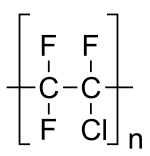PCTFE
 |
|
| Names | |
|---|---|
| Other names
Poly(1-chloro-1,2,2-trifluoroethylene)
Poly(ethylene trifluoride chloride) Polymonochlorotrifluoroethylene Poly(trifluoroethylene chloride) Poly(chlorotrifluoroethylene) Poly(trifluorochloroethene) Poly(chlorotrifluoroethene) Poly(trifluorovinyl chloride) Poly(vinyl trifluorochloride) Kel-F 300; Kel-F 81 |
|
| Identifiers | |
| Abbreviations | PCTFE, PTFCE |
| ChemSpider |
|
| ECHA InfoCard | 100.120.473 |
| MeSH | Polychlorotrifluoroethene |
| Properties | |
| (C2ClF3)n°° | |
| Molar mass | Variable |
|
Except where otherwise noted, data are given for materials in their standard state (at 25 °C [77 °F], 100 kPa).
|
|
|
|
|
| Infobox references | |
Polychlorotrifluoroethylene (PCTFE or PTFCE) is a thermoplastic chlorofluoropolymer with the molecular formula (CF2CClF)n, where n is the number of monomer units in the polymer molecule. It is similar to polytetrafluoroethene (PTFE), except that it is a homopolymer of the monomer chlorotrifluoroethylene (CTFE) instead of tetrafluoroethene. It has the lowest water vapor transmission rate of any plastic.
It was discovered in 1934 by Fritz Schloffer and Otto Scherer who worked at IG Farben Company, Germany.
After World War II, PCTFE was commercialized under the trade name of Kel-F 81 by M W Kellogg company in early 1950s. The name "Kel-F" was derived from "Kellogg" and "fluoropolymer", which also represents other fluoropolymers like the copolymer poly(chlorotrifluoroethylene-co-vinylidene fluoride) (Kel-F 800). These were acquired by 3M Company in 1957. But 3M discontinued manufacturing of Kel-F by 1996.
PCTFE resin is now manufactured in different trade names such as Neoflon PCTFE from Daikin or Aclon from Allied Signal. However, Kel-F remains the most commonly used trade name still today. PCTFE films are sold under the tradename Aclar by Allied Signal. Tradenames of PCTFE in other manufacturing companies include Hostaflon C2 from Hoechst, Fluon from ICI, Voltalef from Arkema, Aclar from Honeywell, Plaskon from Allied Chemical Corporation, Halon from Ausimont USA, and Ftoroplast-3 in USSR and Russian Federation.
...
Wikipedia
